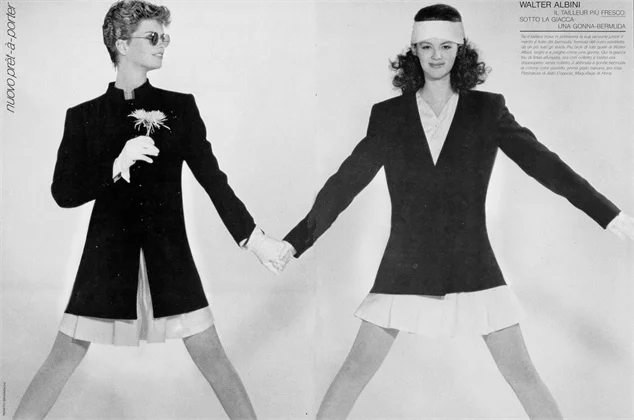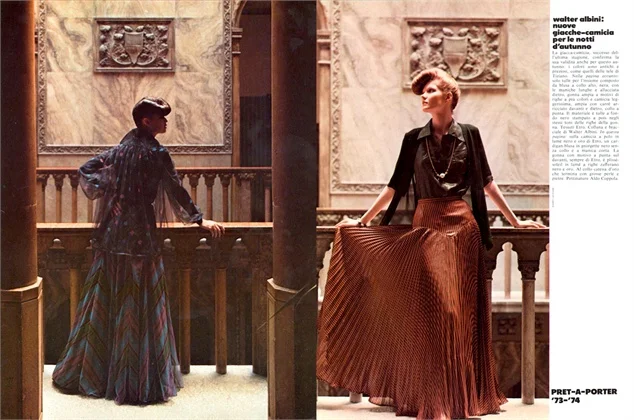DESIGN STUDY: WALTER ALBINI
I'm working on shooting the lookbook for my new collection and I keep coming back to the work of Walter Albini. Walter Albini was an obscure Italian designer until about 2010, when a book called, Walter Albini and His Times: All Power to the Imagination by Maria Luisa Frisa was published. I was given this book as a Christmas gift in 2010 and continue to reference the it for my own work today.
Being credited for pioneering Italian Prêt-à-Porter, Albini was among the first to create ready-made clothing in Europe. Prior to Coco Chanel, most women's clothing was made to measure through the early 20th century. But Albini, was said to be "the designer who came out de l'atelier to enter the factory." (For anyone who knows me personally, perhaps this is why I connect with him so much, given that I'm always in the trenches at the factories).
In his teens, Albini was the only male student to enroll at the Institute of Art, Design and Fashion in Turin, Italy, and by the mid 1960s, he was working as an illustrator in Paris. From here, Albini met Coco Chanelle, and worked alongside a number of designers including Mariuccia Mandelli, the designer of Krizia, and Karl Lagerfeld, who also worked with Krizia at the time. During this period, Albini studied the industrial methods of knitting and textile milling, and he worked to standardize sizing, cutting and sewing for ready to wear garments made in a factory setting.
After a successful and ambitious runway show that featured over 100 models (and 100 looks) in Italy in 1969, and working simultaneously with five major fashion houses in the early 1970s where he debuted the first-ever loose fitting men's shirt and bare breasts on the runway, Albini began his own line, Walter Albini (produced by then Italian 'it-brand' Misterfox) where he reimagined women in blazers, wearing trousers and shirt-dresses. Much like Coco Chanel's adaptation of menswear in women's fashion, Albini pushed the limits of modern women's dress, working to create a 'total look' with his designs, from head to toe, designing everything from buttons and fabrics, to clothing, hats, accessories, belts and shoes to complete the package.
During this time, Albini also designed several interiors to serve as spaces for showrooms and runway presentation venues where he showcased his work with other lines and his own to press and the fashion milieu, often setting tables just to be shot for Casa Vogue where he created tableware, flatware and other home goods using prints he designed for fabrics as details.
But without much commercial support, Albini struggled for a few years during the mid-1970s, eventually leaving his collaboration with Misterfox, opting to take a break from design to travel for a few years. Upon his return, Albini made an uncharacteristic comeback, creating two Haute Couture collections where he presented the idea of atelier-produced garments to be sold as ‘teletta,’ (his take on undergarments) or textiles to be worn in various ways. However, following these two collections, Albini returned to ready-to-wear, designing some of my favorite collections with Italian brand Trell as well as with his own line, up through the 1980s.
Sadly, Albini's life was cut short, at the age of 42 (I can't find the cause of his death anywhere), but despite his short career, he was not only was prolific in his fashion design, but his concepts of advertising, runway shows as performance and his overall approach to high fashion heavily influences the fashion world today. Loud music on the catwalk is played with thanks to Albini, high designed interiors for showrooms and retails stores were first made by him, and unisex clothing was taken a step further than Chanel had done it to encompass menswear for women and women's wear for men. His attention to detail, ability to see new ideas through and willingness to learn processes made him an inventor. Much of what I do is rooted in what Albini did before me, and I'm sure many other designers, whether they're conscious of it or not, are greatly influenced by the work of Walter Albini.
Walter Albini in his own design, 1976
Courtney Bagtazo, © Bagtazo 2015


























